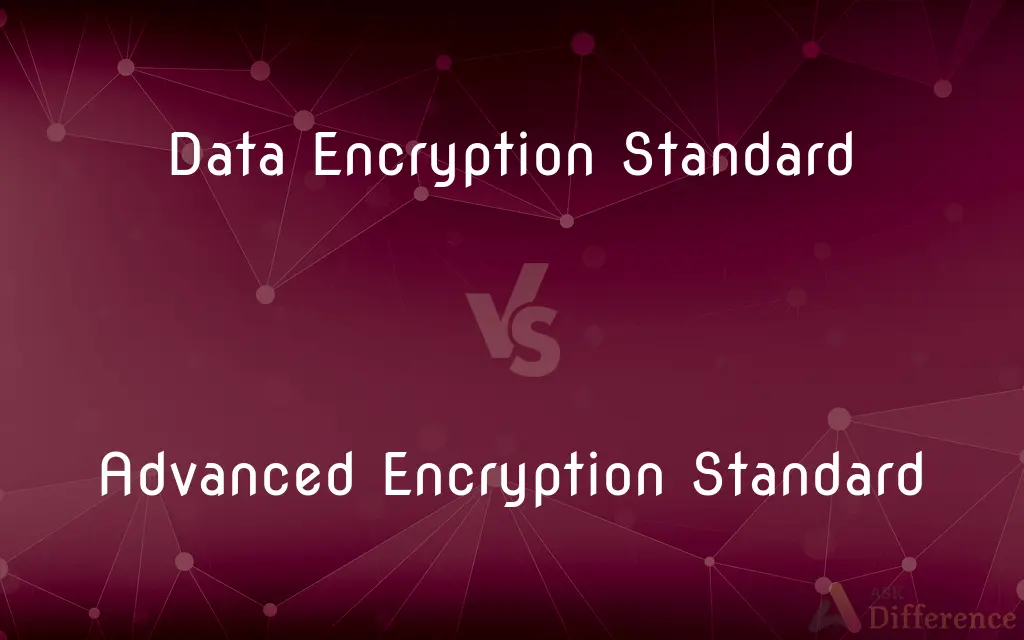Data Encryption Standard vs. Advanced Encryption Standard — What's the Difference?
By Tayyaba Rehman — Published on January 1, 2024
DES is an outdated encryption algorithm using 56-bit keys, whereas AES is a modern standard with key sizes up to 256 bits, offering enhanced security.

Difference Between Data Encryption Standard and Advanced Encryption Standard
Table of Contents
ADVERTISEMENT
Key Differences
Data Encryption Standard (DES) was once the benchmark for encrypting electronic data, used globally for its simplicity and effectiveness during its time. Advanced Encryption Standard (AES), on the other hand, was developed to replace DES when its vulnerabilities became apparent. DES employs a 56-bit key, which was sufficient in the past but now is considered insecure against brute-force attacks, whereas AES can use 128, 192, or 256-bit keys, making it exponentially stronger.
In the realm of cybersecurity, DES is considered a pioneering symmetric-key algorithm, setting the stage for data protection protocols. However, AES, established as a federal standard in the early 2000s, embodies the evolution of encryption, offering robust protection suitable for government and commercial use. While DES encrypts data in 64-bit blocks, AES's block size is 128 bits, which means it's more efficient at securing large amounts of data.
The Data Encryption Standard has a complex history, marked by controversies and suspicions of built-in vulnerabilities that could be exploited by sophisticated attackers. In contrast, the Advanced Encryption Standard was subjected to a public review and selection process, ensuring a transparent and secure choice for data encryption. DES's structure, based on a Feistel network, is less flexible than AES's substitution-permutation network, which contributes to the latter's strength.
Although DES was revolutionary, its single key for encryption and decryption became its Achilles' heel. AES, with its variable key sizes and ability to resist all known practical attacks, stands as the preferred choice for securing sensitive information. Furthermore, DES operates on a slower algorithm compared to the speed and efficiency of AES, which is designed to work well both in hardware and software across a variety of platforms.
To summarize, the Data Encryption Standard is an encryption relic, overtaken by the Advanced Encryption Standard's superior design and capabilities. AES's agility and strength ensure it remains the gold standard for data security, whereas DES is now relegated to the history books, a stepping stone to more advanced cryptographic techniques.
ADVERTISEMENT
Comparison Chart
Key Length
56-bit key
128, 192, or 256-bit keys
Encryption Block Size
64-bit blocks
128-bit blocks
Algorithm Type
Symmetric block cipher
Symmetric block cipher
Security Level
Vulnerable to brute-force attacks
Resistant to all known practical attacks
Adoption Era
Adopted in 1977
Adopted in 2001
Compare with Definitions
Data Encryption Standard
DES was the first encryption standard adopted by the U.S. government.
The Data Encryption Standard served as the government's encryption tool for over two decades.
Advanced Encryption Standard
AES operates on a block cipher algorithm known for its speed and efficiency.
The Advanced Encryption Standard's efficiency makes it suitable for encryption across multiple platforms.
Data Encryption Standard
DES utilizes a 56-bit key size for the encryption process.
Due to its 56-bit key size, the Data Encryption Standard was eventually deemed insufficient for protecting top-secret information.
Advanced Encryption Standard
AES is resilient against various cryptographic attacks, including brute-force.
The security firm recommended the Advanced Encryption Standard to protect their client's digital assets.
Data Encryption Standard
DES is a symmetric-key algorithm for encrypting electronic data.
The bank initially secured transactions with Data Encryption Standard but has since moved to more advanced encryption methods.
Advanced Encryption Standard
AES was established to replace DES due to its stronger security features.
With the adoption of the Advanced Encryption Standard, companies gained a more robust defense against data breaches.
Data Encryption Standard
DES has been superseded by more secure encryption standards.
Although the Data Encryption Standard is now obsolete, it laid the groundwork for modern cryptographic protocols.
Advanced Encryption Standard
AES was the result of a public competition to find a successor for DES.
The selection of the Advanced Encryption Standard marked a significant milestone in the history of cryptography.
Data Encryption Standard
DES encrypts data using the Feistel network structure.
The Data Encryption Standard's reliance on the Feistel structure made it a target for criticism regarding its security.
Advanced Encryption Standard
AES is a widely used encryption standard that secures data with keys up to 256 bits.
The Advanced Encryption Standard is approved by the NSA for securing classified information.
Common Curiosities
How is data encrypted using DES?
Data is encrypted in 64-bit blocks using a 56-bit key and the Feistel network structure.
What is the block size for AES encryption?
AES encrypts data in 128-bit blocks.
When did AES become the federal standard?
AES became the federal standard in 2001.
Is AES the most secure encryption standard available?
AES is currently one of the most secure encryption standards widely adopted for a variety of security purposes.
Why is the Advanced Encryption Standard (AES) more secure than DES?
AES offers larger key sizes and a more secure encryption algorithm, making it resistant to brute-force attacks and other cryptographic threats.
What are the key sizes used in AES?
AES uses key sizes of 128, 192, or 256 bits.
What is the Data Encryption Standard (DES)?
DES is a symmetric-key algorithm for encrypting data, using a 56-bit key.
Why was DES replaced by AES?
DES was replaced due to vulnerabilities that made it susceptible to brute-force attacks, which AES mitigates with its larger key sizes and stronger encryption method.
Can DES still be used for encryption?
While DES can still technically be used, it is not recommended due to its weak security compared to modern standards like AES.
Is AES suitable for hardware and software applications?
Yes, AES is designed to be efficient in both hardware and software across various platforms.
What type of cipher is DES?
DES is a symmetric block cipher.
Was there a public review process for AES?
Yes, AES was selected through a public competition and review process to ensure transparency and security.
What makes AES resistant to attacks?
AES's complex algorithm, larger key sizes, and advanced structure make it resistant to all known practical attacks.
When was DES officially adopted?
DES was officially adopted as a federal standard in 1977.
Has AES ever been successfully attacked?
As of the last update, AES has not been broken by any practical cryptographic attack when implemented correctly.
Share Your Discovery

Previous Comparison
SOAP vs. WSDL
Next Comparison
Ciliated Epithelial Cell vs. Squamous Epithelial CellAuthor Spotlight
Written by
Tayyaba RehmanTayyaba Rehman is a distinguished writer, currently serving as a primary contributor to askdifference.com. As a researcher in semantics and etymology, Tayyaba's passion for the complexity of languages and their distinctions has found a perfect home on the platform. Tayyaba delves into the intricacies of language, distinguishing between commonly confused words and phrases, thereby providing clarity for readers worldwide.
















































